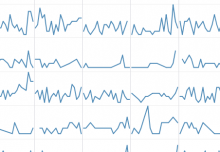 Data is a most valuable asset for enterprises. This is true for any standalone source, such as what is an ERP or a CRM database. However, combining it with other internal information and external sources in a data mashup can exponentially increase the business benefits.
Data is a most valuable asset for enterprises. This is true for any standalone source, such as what is an ERP or a CRM database. However, combining it with other internal information and external sources in a data mashup can exponentially increase the business benefits.
An enterprise data warehouse is the traditional solution for companies seeking to mash up data. An accordingly, traditional business intelligence (BI) applications rely on data warehouses for integrated, pan-organizational information. Now with new BI tools such as InetSoft’s, it is a lot easier for business analysts and end-users alike to access data from several systems and combine it on the fly to create whatever ad hoc or repetitive analysis is required. Real-time data mashup that merges both internal and external data from where it resides is the more elegant and timely data analytics solution.
The Timely Solution
The combination of a multitude of data sources for analysis isn’t an entirely new concept and has been in use for quite some time. But in the past, IT departments had to design ETL processes to extract data and transform it into metrics that a single dashboard or report could use. Oftentimes custom data connectors had to be built in order to ensure the BI and analytics applications were receiving proper data from the data stores.
Nowadays, with modern self-service BI tools like InetSoft’s, the process of gathering information has become a lot simpler. In fact, new data sources can now be integrated into the application via point-and-click interfaces, averting the need for technical expertise and time-consuming data preparation steps.
Better Data Usage and Better Analytics
Too often it happens that companies underutilize their data whether it’s in a customer service database or any other information in the company’s other data stores. It ends up going unused because only certain departments can access each store, or the effort to make it available to others is too high. However, the ability to combine data sources with modern BI tools has proved to be effective for data analysis as well as for gaining a broader understanding of business operations. As such data mashup tools ensure that the data is not just laying around in spreadsheets; it is accessible throughout the organization.
Some organizations might be trepidatious about handing over the responsibility of blending multiple data sets via self-service tools to business. They might try to pull in data from unreliable sources or create a data mashup using unrelated or incompatible sources. This is why some businesses prefer sticking to focused projects with a better chance of success as compared to widening current analytics initiatives.
Mashups Fill Data Holes
The value of information from other sources increases when it is combined with any other internal data. Such combinations allow sales and marketing teams, to validate their data and fill in holes present in the customer records. Accurate customer information is vital for every business because it helps in knowing and understanding their customers. Data mashup permits a holistic view of the sales funnel from marketing campaigns, lead generation sources to opportunity creation and closing sales.
More and more, as companies have gotten very good about capturing data, it ends up leading to mountains of inaccessible data given their current set of reporting tools. This is the Big Data problem. Companies have a collection of ostensibly unrelated data, irrespective of its format (traditional structured data or free text), and data mashup engines can combine those sources. Big Data exists externally as well in cloud applications or public sources, and here again data mashup tools are indispensable.
Wrapping Up
Data mashups tools have become one of the most critical elements of successful business intelligence environments. These tools are like a guiding light, which when missing makes it difficult to see what the truth is.



